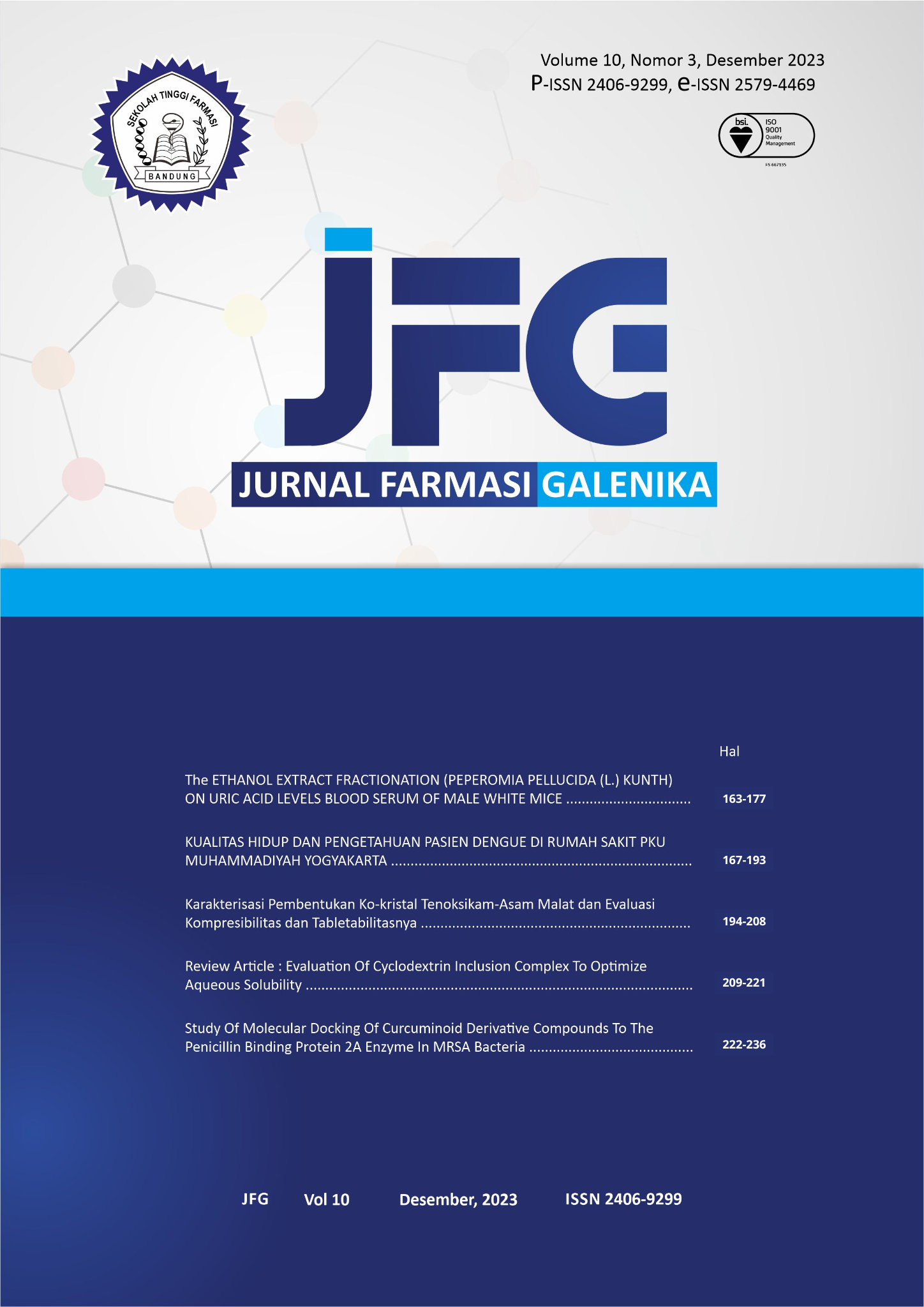Study Of Molecular Docking Of Curcuminoid Derivative Compounds To The Penicillin Binding Protein 2A Enzyme In MRSA Bacteria
DOI:
https://doi.org/10.70410/jfg.v10i3.322Abstract
Methicillin-resistant Staphylococcus aureus (MRSA) is a bacterium that is resistant to ?-lactam antibiotics such as methicillins, a clinical problem that continues to affect the entire world. Resistance occurs as a result of the structural modification of Penicillin Binding Protein Penicilin Binding (PBP) MRSA. An organic active compound with antibacterial properties has sparked public interest, one of which is curcumin, which is known to have powerful antibacteric potential and can damage bacterial membranes. The aim of this study is to identify a compound of curcuminoid derivatives that could potentially be an antibacterial drug candidate for MRSA with in silico studies using molecular docking methods. The results obtained curcumin compounds have a free-binding energy of -5,56 kcal/mol, de-methoxy curcumine -6,25 kcal /mol and bis-demethoxy curcumin -6,24 kkal /mol. The interactions formed indicate the affinity of binding, from the data obtained all ligans possess good affinities even though the value of free-binding energy is lower than natural ligans.
Downloads
References
Bai, Z., Chen, M., Lin, Q., Ye, Y., Fan, H., Wen, K., Zeng, J., Huang, D., Mo, W., Lei, Y., & Liao, Z. (2021). Identification of Methicillin-Resistant Staphylococcus Aureus From Methicillin-Sensitive Staphylococcus Aureus and Molecular Characterization in Quanzhou, China. Frontiers in Cell and Developmental Biology, 9(January), 1–12. https://doi.org/10.3389/fcell.2021.629681
Beceiro, A., Tomás, M., & Bou, G. (2013). Antimicrobial resistance and virulence: A successful or deleterious association in the bacterial world? Clinical Microbiology Reviews, 26(2), 185–230. https://doi.org/10.1128/CMR.00059-12
Bhagyashree L, J., & Sachin H, R. (2021). Drug Designing in Discovery Studio. Indian Journals.Com, 14(2), 135–138. https://doi.org/10.5958/0974-4150.2021.00025.0
Bouley, R., Kumarasiri, M., Peng, Z., Otero, L. H., Song, W., Suckow, M. A., Schroeder, V. A., Wolter, W. R., Lastochkin, E., Antunes, N. T., Pi, H., Vakulenko, S., Hermoso, J. A., Chang, M., & Mobashery, S. (2015). Discovery of antibiotic (E)-3-(3-carboxyphenyl)-2-(4-cyanostyryl)quinazolin-4(3 H)-one. Journal of the American Chemical Society, 137(5), 1738–1741. https://doi.org/10.1021/jacs.5b00056
Cho, H., Uehara, T., & Bernhardt, T. G. (2014). Beta-lactam antibiotics induce a lethal malfunctioning of the bacterial cell wall synthesis machinery. Cell, 159(6), 1300–1311. https://doi.org/10.1016/j.cell.2014.11.017
Chomnawang, M. T., Surassmo, S., Wongsariya, K., & Bunyapraphatsara, N. (2009). Antibacterial Activity of Thai Medicinal Plants against Methicillin-resistant Staphylococcus aureus. Fitoterapia, 80(2), 102–104. https://doi.org/10.1016/j.fitote.2008.10.007
Dixon, S. L., Smondyrev, A. M., Knoll, E. H., Rao, S. N., Shaw, D. E., & Friesner, R. A. (2006). PHASE: A new engine for pharmacophore perception, 3D QSAR model development, and 3D database screening: 1. Methodology and preliminary results. Journal of Computer-Aided Molecular Design, 20(10–11), 647–671. https://doi.org/10.1007/s10822-006-9087-6
Huey, R., Morris, G. M., & Forli, S. (2012). Using AutoDock 4 and AutoDock Vina with AutoDockTools: A Tutorial. The Scripps Research Institute Molecular, 32.
Joe, B., Vijaykumar, M., & Lokesh, B. R. (2004). Biological Properties of Curcumin-Cellular and Molecular Mechanisms of Action. Critical Reviews in Food Science and Nutrition, 44(2), 97–111. https://doi.org/10.1080/10408690490424702
Kementrian Kesehatan RI. (2018). Profil Kesehatan Indonesia 2018 [Indonesia Health Profile 2018]. http://www.depkes.go.id/resources/download/pusdatin/profil-kesehatan-indonesia/Data-dan-Informasi_Profil-Kesehatan-Indonesia-2018.pdf
Kim, S., Chen, J., Cheng, T., Gindulyte, A., He, J., He, S., Li, Q., Shoemaker, B. A., Thiessen, P. A., Yu, B., Zaslavsky, L., Zhang, J., & Bolton, E. E. (2019). PubChem 2019 update: Improved access to chemical data. Nucleic Acids Research, 47(D1), D1102–D1109. https://doi.org/10.1093/nar/gky1033
Llarrull, L. I., Fisher, J. F., & Mobashery, S. (2009). Molecular basis and phenotype of methicillin resistance in Staphylococcus aureus and insights into new ?-lactams that meet the challenge. Antimicrobial Agents and Chemotherapy, 53(10), 4051–4063. https://doi.org/10.1128/AAC.00084-09
Mutiah, R. (2015). EVIDENCE BASED KURKUMIN DARI TANAMAN KUNYIT (Curcuma longa) SEBAGAI TERAPI KANKER PADA PENGOBATAN MODERN. Jurnal Farma Sains, 1(1), 28–41.
Nurhani. (2010). PERBEDAAN PREVALENSI DAN POLA RESISTENSI Staphylococcus aureus PADA TIGA SEKOLAH DASAR SDN Pandean Lamper 02 , SD Kristen II YSKI , dan SD Manyaran 01 di Kota Semarang UNIVERSITAS DIPONEGORO TAHUN 2010. In Universitas Diponegoro.
Pebriana, R. B., Romadhon, A. F., Yunianto, A., Rokhman, M. R., Fitriyah, N. Q., Jenie, R. I., & Meiyanto, D. E. (2012). DOCKING KURKUMIN DAN SENYAWA ANALOGNYA PADA RESEPTOR PROGESTERON: STUDI INTERAKSINYA SEBAGAI Selective Progesterone Receptor Modulators (SPRMs) DOCKING OF CURCUMIN AND ITS ANALOGUES ON PROGESTERONE RECEPTOR: INTERACTION STUDIES FOR Selective Progesterone . Pharmacon, 13(2), 55.
Rani, N., Vijayakumar, S., Thanga Velan, L. P., & Arunachalam, A. (2014). Quercetin 3-O-rutinoside mediated inhibition of PBP2a: Computational and experimental evidence to its anti-MRSA activity. Molecular BioSystems, 10(12), 3229–3237. https://doi.org/10.1039/c4mb00319e
Tyagi, P., Singh, M., Kumari, H., Kumari, A., & Mukhopadhyay, K. (2015). Bactericidal activity of curcumin I is associated with damaging of bacterial membrane. PLoS ONE, 10(3), 1–15. https://doi.org/10.1371/journal.pone.0121313
Yang, L., Wen, K. S., Ruan, X., Zhao, Y. X., Wei, F., & Wang, Q. (2018). Response of plant secondary metabolites to environmental factors. Molecules, 23(4), 1–26. https://doi.org/10.3390/molecules23040762
Yusuf, D., Davis, A. M., Kleywegt, G. J., & Schmitt, S. (2008). An alternative method for the evaluation of docking performance: RSR vs RMSD. Journal of Chemical Information and Modeling, 48(7), 1411–1422. https://doi.org/10.1021/ci800084x
Downloads
Published
How to Cite
Issue
Section
Citation Check
License
Authors who publish in Jurnal Farmasi Galenika agree to the following terms:
This license enables reusers to distribute, remix, adapt, and build upon the material in any medium or format, so long as attribution is given to the creator. The license allows for commercial use. CC BY includes the following elements:
BY: credit must be given to the creator.
You are free to:
- Share — copy and redistribute the material in any medium or format for any purpose, even commercially.
- Adapt — remix, transform, and build upon the material for any purpose, even commercially.
- The licensor cannot revoke these freedoms as long as you follow the license terms.
Under the following terms:
- Attribution — You must give appropriate credit , provide a link to the license, and indicate if changes were made . You may do so in any reasonable manner, but not in any way that suggests the licensor endorses you or your use.
- No additional restrictions — You may not apply legal terms or technological measures that legally restrict others from doing anything the license permits.
Notices:
You do not have to comply with the license for elements of the material in the public domain or where your use is permitted by an applicable exception or limitation .
No warranties are given. The license may not give you all of the permissions necessary for your intended use. For example, other rights such as publicity, privacy, or moral rights may limit how you use the material.











